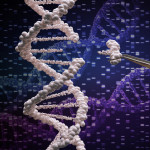A promising treatment that keeps CD4 cells from producing a key receptor on their surface, thus potentially blocking viral infection, is set to begin early safety studies in humans according to an announcement by the treatment’s developer, Sangamo BioSciences, Inc.
HIV typically uses the CCR5 receptor on the surface of CD4 cells in order to infect the cells and reproduce. When cells lack CCR5, or have had their receptors blocked by a drug such as Selzentry (maraviroc), HIV typically can’t infect them. While a small percentage of people are born with a genetic mutation that keeps their cells from making CCR5 receptors, most people with HIV don’t have this mutation. Scientists have long wondered whether it might be possible to genetically reprogram people’s CD4 cells to stop producing CCR5 receptors.
Zinc finger DNA-binding protein nuclease (ZFN), a technology developed by Sangamo, blocks the production of CCR5 on CD4 cells. It reportedly worked in animal studies, and Sangamo is partnering with the University of Pennsylvania to conduct its first human clinical trial.
The researchers will take CD4 cells from 12 HIV-positive patients, genetically modify the cells with the Sangamo technology and then reinfuse the cells back into each patient. Patients will be treated one at a time with a delay of at least 21 days between each patient to ensure the highest degree of safety.
“This is the first time that we have had the ability to make a patient’s [CD4 cells] permanently resistant to infection by CCR5-specific strains of HIV, and we are very excited to begin a clinical trial of this novel ZFN-based therapy,” said Carl June, MD, one of the lead investigators from the University of Pennsylvania School of Medicine.
Even if the technology is proved safe, it is possible that the therapy may only work in people who have not developed sufficient quantities of HIV that use a different receptor, CXCR4, as is the case with Selzentry.
Advertisement
Advertisement
Advertisement






2 Comments
2 Comments